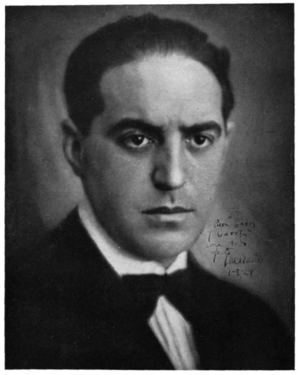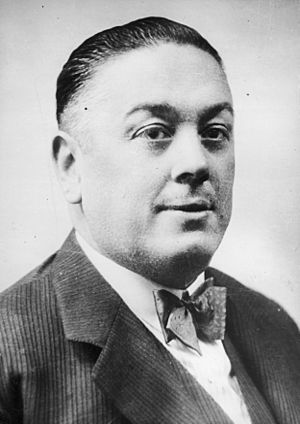Felipe Sánchez Román y Gallifa facts for kids
Quick facts for kids
Felipe Sánchez Román y Gallifa
|
|
|---|---|
 |
|
| Deputy of Madrid | |
| In office 28 June 1931 – 9 October 1933 |
|
| Minister without Portfolio | |
| In office 19 July 1936 – 19 July 1936 |
|
| Personal details | |
| Born | 12 March 1893 Madrid, Spain |
| Died | 21 January 1956 (aged 62) Mexico City, Mexico |
| Occupation | Jurist |
Felipe Sánchez-Román y Gallifa (born March 12, 1893 – died January 21, 1956) was an important Spanish expert in law. He taught law at the Central University of Madrid for many years.
He believed that the old government, a monarchy, should be replaced. He became a representative for Madrid in 1931. Many political leaders respected his fair and balanced ideas.
In 1934, he started a small but important political group called the Partido Nacional Republicano (PNR). He wanted to create a stable government for Spain. When the Spanish Civil War began in 1936, he moved to France. In 1939, he went to Mexico, where he continued to teach law.
Contents
Early Life and Education (1893–1915)
Felipe Sánchez Román y Gallifa was born in Madrid, Spain, on March 12, 1893. His father, Felipe Sánchez Román, was also a law professor. His mother was Encarnación Gallifa Lombarte.
Felipe went to high school in Madrid. He finished his studies with excellent grades in 1909.
He then studied law at the Central University of Madrid. He earned his law degree in 1913. He continued his studies and received his doctorate in law in 1914. His special project was about the government's power to make people follow laws.
In 1915, he started working as a temporary assistant at the Central University of Madrid. He taught subjects like Natural Law and Roman Law. He officially became a Doctor of Law in 1916.
Starting His Career (1915–1931)
In 1916, Felipe Sánchez-Román became a professor of Civil Law at the Central University of Madrid. This was the same position his father had held. He taught there from 1916 to 1929.
In 1917, he married Ángeles Correa Ruiz. They had five children together. From 1918 to 1939, he also worked as a lawyer in many Spanish cities.
In 1929, Sánchez-Román left his teaching job. He felt he could not continue because of strong public accusations from the government leader. However, the Supreme Court later ruled that he had been wrongly dismissed. He was able to return to his teaching position in 1930.

Sánchez-Román became involved in politics. In 1930, he joined a meeting called the Pact of San Sebastián. This was an important meeting where different groups came together to plan a new, non-monarchist government for Spain. He was asked to join a "revolutionary committee" that later became the first temporary government of the Second Spanish Republic.
He also helped defend leaders who were arrested after a failed uprising in December 1930. His strong defense showed his passion for change.
The Second Spanish Republic (1931–1936)
In April 1931, Sánchez-Román was put in charge of a group planning changes for farming in Spain. However, the government did not accept his plans.
He became a representative for Madrid in the Constituent Cortes (a type of parliament) in July 1931. He spoke about important topics like farming, religion, and the laws for different parts of Spain.
He was considered a possible leader for the country in September 1931. However, he left a government advisory group because he was not happy with how things were going.
From 1931 to 1939, Sánchez-Román was part of the Spanish team for the Permanent Court of Arbitration in The Hague. This court helps solve problems between countries. He also taught law at the Central University of Madrid from 1933 to 1936.

In 1934, Sánchez-Román started his own political group, the Partido Nacional Republicano (PNR). This was a small party made up mostly of educated professionals. He wanted his party to help bring together different groups on the left side of politics. He was known as a moderate and responsible leader.
In 1935, he wrote an article calling for different left-wing groups to work together.
When a large group called the Popular Front was forming in January 1936, Sánchez-Román decided not to join. He was worried that the group included Communists who might want to destroy the country's constitution. He wanted the group to promise to stop revolutionary actions and control youth groups that acted like armies.
On January 15, 1936, he closed his party, the PNR. Later, when a new government was formed, Sánchez-Román was offered the job of Premier, but he turned it down. He did not think the government would be strong enough.
In May 1936, another leader, Manuel Azaña, became President. Azaña would have preferred Sánchez-Román as president, but this was not possible because Sánchez-Román was not part of the Popular Front. As problems in Spain grew, Sánchez-Román suggested reforms and ways to stop violence. However, his advice was not accepted.
Spanish Civil War (1936–1939)

After a military uprising began in July 1936, Sánchez-Román agreed to join a new government. This government, led by Diego Martínez Barrio, tried to keep the country stable. Sánchez-Román believed that giving weapons to workers, as some demanded, would be dangerous.
However, this government lasted only a few hours. It faced strong opposition and was quickly replaced.
Sánchez-Román's family moved to France in August 1936. He stayed in Madrid for a few months but left in December 1936. His friend Indalecio Prieto advised him to leave because his life was in danger. By August 1937, he was living in France.
In February 1939, the new government of General Francisco Franco removed Sánchez-Román from his university position.
Life in Mexico (1939–1956)
After the Spanish Civil War ended, Sánchez-Román moved from France to New York City. He was offered a teaching job at Columbia University. However, he chose to accept an invitation from President Lázaro Cárdenas to move to Mexico.
He arrived in Mexico City by train in April 1939 with his wife and five children. He lived there for the rest of his life.
From 1940 to 1946, he worked as a legal advisor to the President of Mexico. He helped with legal issues related to the oil industry. In 1939, he suggested creating a new law research center at the National Autonomous University of Mexico (UNAM). This center was created in 1940, and Sánchez-Román became its first director. He later taught comparative law at UNAM.
Sánchez-Román also worked as a lawyer, giving legal advice to many companies. He joined a group of Spanish intellectuals in Mexico. His wife passed away in 1949.
In 1950, he became a Doctoral Professor of Comparative Law at UNAM. However, his health declined, and he had to take a break from teaching in 1953. He continued to advise the President of Mexico in 1953.
Felipe Sánchez-Román died in Mexico City on January 23, 1956, after a long illness.
Images for kids
See also
 In Spanish: Felipe Sánchez-Román para niños
In Spanish: Felipe Sánchez-Román para niños


